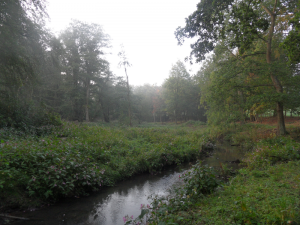Andrew Heald MICFor reports on April’s Institute of Fisheries Management Specialist Conference in Penrith, Cumbria, where he presented a paper.
While not surprised to be the only speaker from the private forestry sector at the Institute of Fisheries Management Specialist Conference, Forestry and Fisheries – Where Next?, I was surprised that Confor was the only commercial private sector representative at all. The ICF National Conference date-clash was, no doubt, a factor. However, forestry was ably supported by Forestry Commission England, Natural Resources Wales, Forest Research (experts included Tom Nisbet and Nadeem Shah), and forestry consultant Dr Scott McG Wilson MICFor.
The 60-strong audience was offered an excellent mix of theory, science, policy and some pragmatic ‘on the ground’ practice on river restoration, and it was not the anti-conifer fight I had initially feared.
The key issues connecting forestry and fisheries are acidification and diffuse pollution. It is worth considering that the former is connected to the afforestation practices of the 1970’s and 1980’s and the latter often with harvesting the same.
The main ‘take home’ message was that almost every stream in every catchment is different, and how that stream reacts to afforestation, deforestation or liming is highly dependent on a number of factors, including the width of buffer strips, depth of peat and underlying geology. The worse possible case of blanket afforestation, on deep peat with no riparian buffer, was resulting in pH as low as 4.3, but there was also a report on research of new planting, near Halladale in the Flow Country in the early 1990s, that had no measurable impact on local fish populations. It is known that a pH level lower than 5.5 will result in permanent damage to salmon roe, even if only at that level for a few hours.
The other key factor in considering forestry and acidification issues is the steep decline in sulphur emissions from UK industry as a result of regulation and improved technology – levels have reduced by 73 per cent to almost zero.
Maximum catchment afforestation levels of 20-30 per cent were mentioned several times, with examples given of highly afforested catchments resulting in high levels of acidification. Several delegates compared this with much of Europe where there are much higher levels of forest cover.

The Forestry Commission has a sensitivity matrix which sets out which parts of the country are vulnerable, and shows that silvicultural practice (particularly buffer strips) is arguably just as important as simple measures of tree cover.
The UK Forestry Standard Guidelines, Forest and Water, were referred to repeatedly and delegates agreed that forestry policy – and practice – is greatly improved, with forestry concerns being specific to a particular stream or catchment.
My own paper, The Role of Productive Woodlands in Water Management, jointly produced by Confor and Forest Research and compiling existing research, demonstrated how productive woodland can reduce flood risk and protect our waterways.
This conference highlighted that, as foresters, we need to take time to understand any criticism, which is often related to insensitive management of conifers at a specific site, and showed how our industry needs to present its research and practices to potentially critical audiences.
Forestry policy and practice has improved hugely over the past 30 years. We have a strong sustainability case which, in around 70 per cent of our forests, is supported by credible independent third-party verification, unlike any other UK land use.
We have a great story, so let’s tell it.
Andrew Heald MICFor, Technical Director, Confor
Find out more…
Download Andrew’s paper at:
http://bit.do/fisheries
The Institute of Fisheries Management is dedicated to the advancement of sustainable fisheries management.
www.ifm.org.uk
